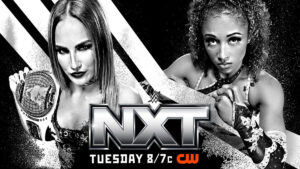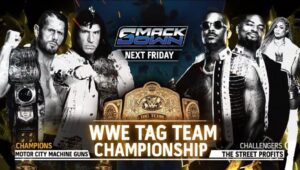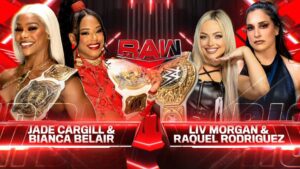With today’s announcement of the return to Toronto, Ontario, Canada – Canada’s largest city with a population of 2.8 million people – of the WWE for next year’s SummerSlam weekend, it brought a huge sigh of relief to Ontario wrestling fans. Although Toronto received Survivor Series back in 2016, it had been a decade since Toronto’s last Pay Per View from the WWE, 2006’s Unforgiven PPV. Their last “Big Four” PPV prior to Survivor Series was SummerSlam in 2004. Many were starting to wonder if Toronto, which the WWE has routinely touted as a A-list wrestling city, had fallen into disfavor with the WWE after being one of the routine destinations for big shows. But the announcement that Toronto was returning to the Big Four rotation, now acquiring SummerSlam only three years after Survivor Series, was music to Canadian wrestling fans in Ontario. Especially considering the WWE’s long standing history with the capital city of Ontario.
BREAKING: As first reported by @ETCanada, @WWE #SummerSlam Week is coming to Toronto NEXT YEAR with #NXTTakeOver, @SummerSlam, #RAW, and #SDLive at @ScotiabankArena! https://t.co/wmYhKnrKj8
— WWE (@WWE) August 27, 2018
MAPLE LEAF WRESTLING

For most of the 20th Century, Canada’s leading NWA territory was Maple Leaf Wrestling (MLW) in Toronto. While Calgary, Montreal, and Vancouver have had very successful territories throughout the century, Maple Leaf Wrestling in Toronto was the largest promotion in Canada. Founded in 1930 by Jack Corcoran as the Queensbury Athletic Club (QAC), it was taken over by John & Frank Tunney in 1939 and rebranded as Maple Leaf Wrestling. It remained in the Tunney family until it closed down in 1986. Throughout the Tunney’s run, it remained the NWA’s top territory in Canada, the northern stomping ground that saw the likes of Ric Flair, Harley Race, Jim Londos, Lou Thesz and countless NWA World Heavyweight Champions all come through to defend their titles. Toronto’s own “Whipper” Billy Watson won the NWA World Heavyweight title in March of 1956, defeating Lou Thesz for the belt in Maple Leaf Gardens, holding it for 239 days, and defending it in Toronto against the likes of Gorgeous George, Dick Hutton, Hans Schmidt and others.

Maple Leaf Wrestling also held exhibition matches featuring other promotions champions, including the World Wide Wrestling Federation (WWWF, pre-WWE) and American Wrestling Association (AWA), which saw World Champions like Bruno Sammartino, Bob Backlund, Nick Bockwinkel, and Verne Gagne working at Maple Leaf Gardens. In 1983, Frank Tunney passed away, and MLW fell into the hands of the Tunneys two sons, Jack Tunney (son of John) and Eddie Tunney (son of Frank). By 1986, they sold the entire territory to Vince McMahon Jr., who himself had recently acquired the WWWF from his own father, Vince McMahon Sr., now rebranded as the World Wrestling Federation (WWF). Maple Leaf Wrestling continued in name only, as the name of one the WWF’s weekly programs, with matches emanating from Canada (most often from Toronto).

WRESTLEMANIA VI

In 1990, Toronto became the first non-US city to get a WrestleMania and it was one of the most memorable main events of all time. WWF World Heavyweight Champion Hulk Hogan faced Intercontinental Champion The Ultimate Warrior in a title for title match in the main event that had the WWE Universe clearly divided – the WWF strayed from it’s standard good guy vs. bad guy storylines and had the two most popular faces in the company against each other, resulting in the elevation of Ultimate Warrior to WWF World Champion.
THE WWE’S CANADIAN DESTINATION

In January of 1997, Toronto got it’s first episode of Monday Night RAW, WWE’s flagship program, for a taping that aired in February. It featured an Intercontinental Championship match with Triple H defending against Marc Mero, Owen Hart & British Bulldog defending their WWF Tag Team titles against Doug Furnas & Phil LaFon, and had a dark match triple threat main event featuring WWF World Heavyweight Champion Shawn Michaels facing Bret “Hitman” Hart and Sid Vicious. In early 1999, they were chosen as the host city for the first Saturday night special edition of RAW, headlined by a gauntlet match that saw “Stone Cold” Steve Austin face a team from The Corporation including Chyna, Kane, Ken Shamrock, Big Bossman, Test and Vince McMahon himself. In the fall of 2001, they got their first every episode of Smackdown!, headlined by Rob Van Dam defeating Steve Austin in a non-title match.

It was 12 years after WrestleMania VI before Toronto would get their next PPV, but once again it was a WrestleMania. And much like the one before, it featured a polarizing match-up that pitted two of the most beloved stars of the time – The Rock facing “Hollywood” Hulk Hogan – in one of the most memorable matches in WrestleMania history at WrestleMania 18. Since then, Toronto has become a prime destination for WWE’s TV programming, hosting dozens of episodes of RAW, Smackdown, Sunday Night Heat, Velocity and other programs. Following 2002’s WrestleMania X-8, their PPV schedule featured SummerSlam (2004), Unforgiven (2006), Roadblock (2016), NXT TakeOver: Toronto (2016), and Survivor Series (2016). With the announcement of SummerSlam for 2019, Toronto will have had as many PPVs in the past three years (4), than in the 25 years prior (4). Toronto has clearly regained it’s value to the WWE and then some.
WORLD CHAMPIONSHIP WRESTLING

When Maple Leaf Wrestling was absorbed by the WWF in the 1980s, the NWA lost its footing in Toronto. Their last show in Toronto was a house show at the CNE Exhibition Stadium in 1990, several months after WrestleMania VI, that was headlined by an NWA United States Championship match featuring Lex Luger defending his title against Sid Vicious. The undercard featured the Fabulous Freebirds (Michael PS Hayes & Jimmy Garvin) vs. Tommy Rich & Ricky Morton, but the rest of the card were either new faces who hadn’t become huge stars yet (like Brian Pillman and “The Juicer” Art Barr) or Canadian locals. Although Torontonians got a rare glimpse of Kevin Nash in his Master Blaster gimmick that night.
Once WCW seceded from the NWA, they tried to run a house show at Toronto’s SkyDome in 1993 – the venue that held over 80,000 people for WrestleMania VI – but despite a stronger card that featured the likes of Vader vs. Sting for the WCW World title, “Stunning” Steve Austin vs. Ricky Steamboat, plus the likes of Chris Benoit, Rick Rude, Paul Orndorff, William Regal and yet another of Kevin Nash’s failed WCW gimmicks, Vinnie Vegas, WCW only drew approximately 3,800 fans. Toronto was clearly still WWF territory.

WCW attempted Toronto again six years later, once it had Canada’s most well known wrestler, Bret “Hitman” Hart, in its camp. They tested the waters with an episode of Monday NITRO in March of 1999 at the Air Canada Centre, to a near capacity crowd, who saw the infamous segment where Bret Hart goaded Goldberg to spear him, only to run into a metal plate under Hart’s hockey jersey. The main event saw “Hollywood” Hulk Hogan defeat Diamond Dallas Page.
They returned to Toronto that fall for the WCW Mayhem PPV, that saw the semi-finals for the vacant WCW World Heavyweight Championship on the card. Canadians Chris Benoit (defeating Jeff Jarrett) and Bret Hart (defeating Sting) advanced to the final main event, with Bret Hart winning his first WCW World Heavyweight Championship at the Air Canada Centre in front of his fellow countrymen.

RING OF HONOR

Since their first foray into Toronto in 2008 with the Northern Navigation event (which saw ROH World Champion Nigel McGuinness defend against Kevin Steen), Ring of Honor (ROH) has returned to Toronto on an almost annual basis, including major PPVs like Death Before Dishonor VII (2009), Death Before Dishonor VIII (2010), All Star Extravaganza V (2013) and All Star Extravaganza VI (2014). When ROH partnered with New Japan Pro Wrestling (NJPW) in 2014, Toronto was one of the first cities to get a Global Wars co-branded event, and has gotten legs of the tours for Global Wars in 2015 and War of the Worlds in 2016, 2017 and this year as well. Kevin Steen (now Kevin Owens in the WWE), won the ROH World Championship in Toronto in 2012.
IMPACT WRESTLING

Although they had a TNA house show back in 2011, it wasn’t until Toronto’s Anthem Entertainment – the parent company of the Fight Network – acquired IMPACT Wrestling that Toronto became a major player for the company. They made their Canadian PPV debut with this year’s Slammiversary XVI, and have taped multiple Twitch and One Night Only specials in Toronto, as well as the last two sets of TV tapings.

THE INDIES

But major promotions like WWE, NJPW, ROH and IMPACT aren’t the only wrestling to hit Toronto. While Maple Leafs Wrestling left a void for a major arena promotion in the area, much like the demise of WCW and ECW caused the vacuum to be filled by emerging indies like ROH, TNA, Pro Wrestling Guerrilla (PWG), Major League Wrestling (MLW) and CHIKARA, Toronto has seen its indie scene explode to it’s most vibrant period ever. Smash Wrestling has become one of Canada’s premiere indie promotions, available worldwide on a multitude of platforms for viewing, but there’s also many other highly successful promotions, like Destiny World Wrestling, Superkick’D, Lucha T.O., Greektown Wrestling and more. And the abundance of top flight indies in Canada’s most populous city has created multiple avenues for many of Ontario – as well as the rest of Canada – to find stages to showcase their wares. Last year, Britain’s WCPW (now Defiant Wrestling), held the Canadian qualifiers for the Pro Wrestling World Cup in Toronto.
Toronto is often compared to New York City. It’s the largest city in it’s country and much of the rest of the country seem to have a love hate relationship with the city. But there’s no denying that “The Big Smoke”, “Hogtown”, whatever you want to call it, that Toronto is Canada’s premier wrestling destination, for promotions and wrestlers worldwide.






